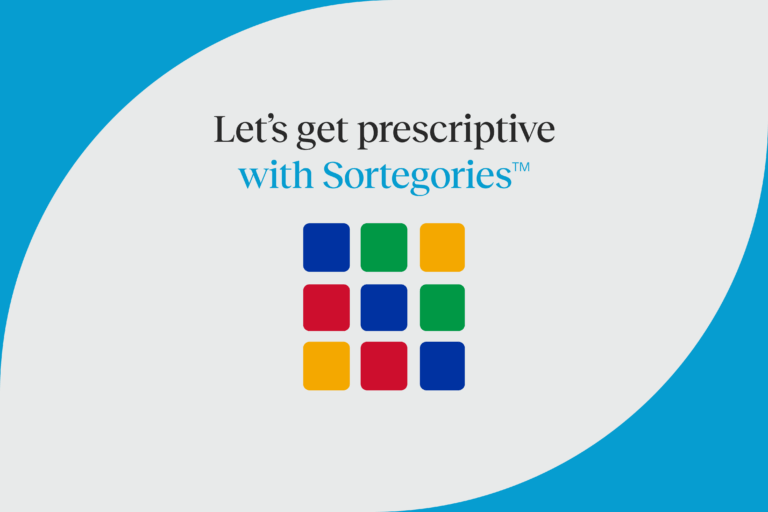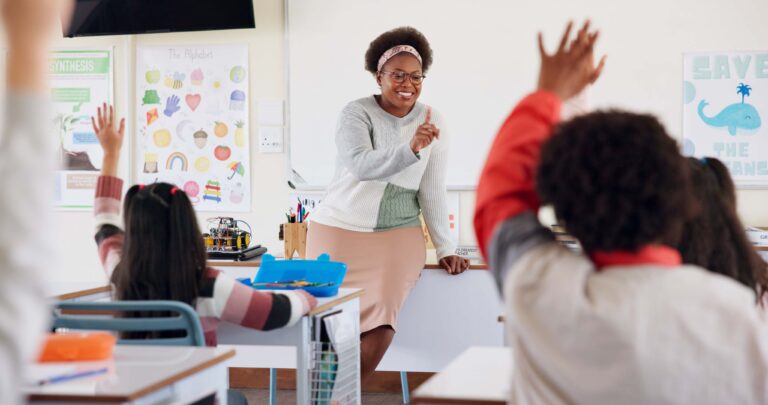Phonics intervention upgrade: Digital integrates with proven pedagogy
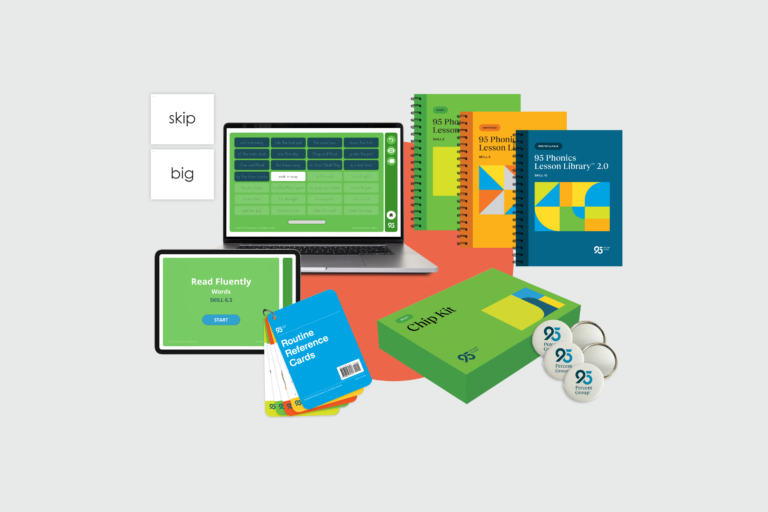
There aren’t many people still debating the fact that children need explicit phonics instruction if we want them to learn to read, and to be lifelong readers and learners. The spotlight on the decades of research we now call the science of reading has cleared a path for a structured literacy approach: explicit, direct instruction that is systematic, sequential, and based in evidence.
In the years since the National Reading Panel published their report on Teaching Children to Read (2000), a variety of approaches emerged to literacy instruction and acquisition with a range of outcomes—many not what schools, districts, and parents expected.
With an uptick in phonics instruction, informed by the science of reading, we’ve seen entire school communities transformed by the power of evidence-based instruction. We’ve also watched the ways in which student participation, engagement, and the delivery of instruction itself has begun to change with the rise in technological capabilities. Much as we know our original and proven approach works well, just the way it is, it is impossible and (not advisable) to avoid change completely.
So we have an opportunity. One where we get to take what we know works, and then add in new, innovative digital options for greater student engagement, time-saving teacher preparation, and built-in supports for some of our more vulnerable learners—all of which leads to a more streamlined learning experience.
Introducing: 95 Phonics Lesson Library™ 2.0 for intervention.
The science behind effective phonics instruction
The science of reading, a collection of decades worth of research about how children learn to read, offers us the code to ensure that all children learn how to read fluently. Through this work we now know that for phonics intervention to be effective it should be direct instruction that is sequential, systematic, and provides plenty of opportunity for practice. A phonics intervention program ideally uses the same routines and language as the students’ Core instruction, lessening the cognitive load and freeing up space for comprehension processes.
Using a gradual release model (“I Do, You Do, We Do”) teachers instruct on skills, offer a chance for guided practice and immediate feedback (reinforcement or redirection), followed by an opportunity for students to practice independently.
With a foundation firmly grounded in reading science, how can we use the new technology available to us to make literacy intervention an even better experience?
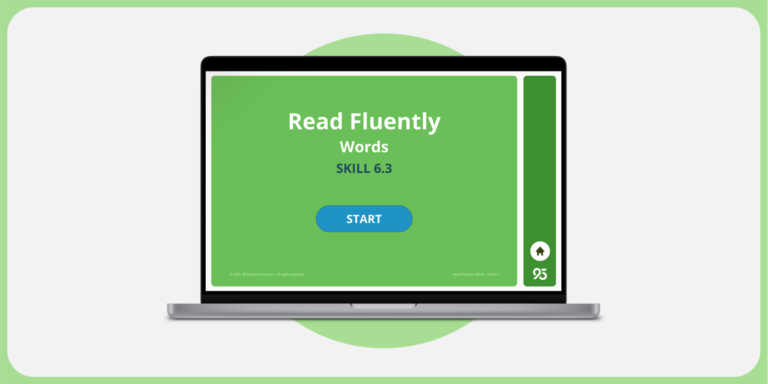
Above is a screen view into the new 95 Phonics Lesson Library 2.0, which features exciting digital capabilities.
The next generation of literacy intervention
For quite a few years now, schools and districts have followed a predictable path: collecting more in-depth data, noticing that students aren’t where they need to be in terms of their foundational literacy skills, and beginning to get curious about how they can better meet the needs of their students.
Many traditional intervention programs rely simply on universal screener data—missing the opportunity to drill down to the specific skills that each student really needs. Additionally, students are often pulled from their regular literacy instruction to work on skills they haven’t mastered yet, missing the instruction they need for grade level literacy skills. Although educator systems for tracking have come a long way, managing all of the progress monitoring and instructional materials for each student can become an enormous logistical challenge.
Bridging research and practice: The digital edge

We believe that the teacher belongs at the center of instruction and our digital strategy reflects that. As we expand our digital offerings, the goal is to integrate into the One95 Literacy Ecosystem the most innovative technology available for amplifying instruction, maximizing our print resources and, ultimately, strengthening student outcomes.
Brad Lindaas
Technology enhances traditional phonics instruction through interactive engagement, immediate feedback, and differentiated learning paths. Digital delivery benefits teachers through streamlined lesson planning and resource management, while students gain from engaging and interactive practice opportunities and consistent instruction. Real-time data collection enables teachers to make informed, “just in time” decisions about intervention strategies and student progress as they go—rather than waiting for the next benchmark screening opportunity. Ultimately, this means that students are moving into and out of intervention more quickly because they are mastering the skills they need to be more proficient readers.
An integrated intervention system: 95 Literacy Intervention System + 95 Phonics Lesson Library 2.0
95 Phonics Lesson Library™ 2.0 is the new instructional component of 95 Literacy Intervention System™, an end-to-end solution for phonics intervention. Teachers will now be able to quickly assess and understand what each student needs, AND assign instruction all from the same place.
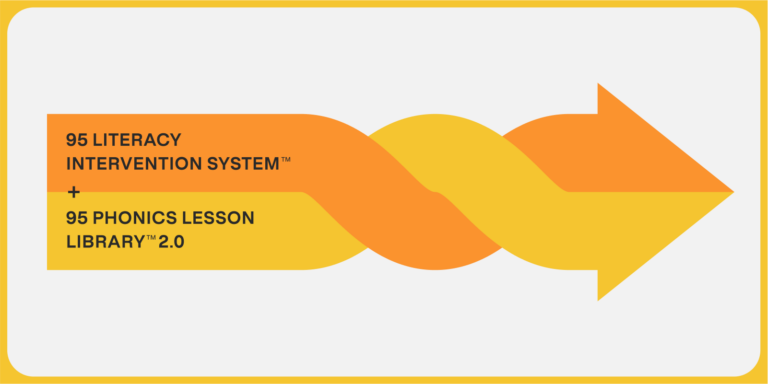
95 Phonics Lesson Library 2.0 integrates seamlessly with 95 Literacy Intervention System™ to make the entire cycle of intervention more efficient and effective.

Get to know 95 Literacy Intervention System™
This new digital system is redefining how schools approach intervention management—connecting assessment, precise instruction, and data-driven monitoring.
95 Literacy Intervention System has offered educators a brand new way to manage the often overwhelming logistics that come with an efficient and effective intervention practice. Now, with the ability to have district-wide data all in one place, everyone invested—from teachers and coaches to building and district administrators—can have an immediate, quick, large-scale view of how students are doing.
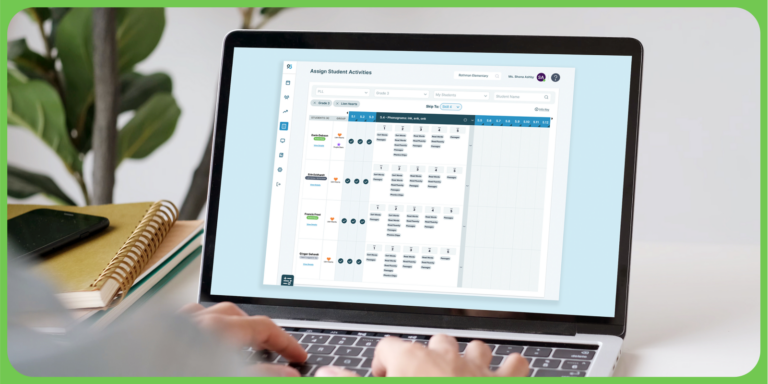
Because we are now reporting progress on Reading Success Plans to parents, and want to show that students are growing, using 95 LIS to capture the data along the way to show how students are progressing through the skills is really helpful to this process.
Libbie Burd
Alongside updates to our trusted print materials, educators will also have exciting new digital innovations. The new digital options which include Student Activity Modules and teacher presentation files will transform the way both students and teachers experience intervention. Here’s why.
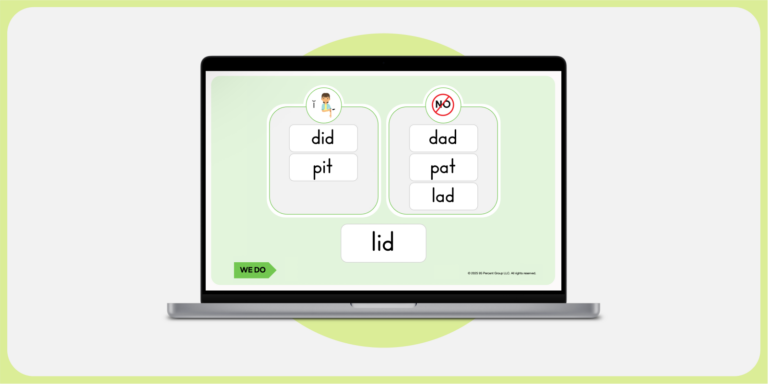
Time saving
With 95 Phonics Lesson Library 2.0, teachers can now both map skill deficits to specific lessons, and integrate in-lesson practice opportunities seamlessly. Our digital platform streamlines lesson preparation and automates resource management, allowing teachers to focus their time on instruction and assessment rather than administrative tasks— moving students more quickly through the skill acquisition they need to close gaps and to accelerate.
More efficient use of resources
The integration with 95 Literacy Intervention System allows for progress to immediately indicate when students are ready to exit intervention. The combination of digital instruction options with hands-on, manipulatives-based learning creates a more inclusive learning environment. This approach intuitively supports diverse learner needs through multi-modal instruction while ensuring alignment across instructional tiers. Additionally, 95 Phonics Lesson Library 2.0 has embedded routines for supporting English Language Learners including skill scaffolding and corrective feedback.
Professional learning
At 95 Percent Group, teacher support remains a steadfast pillar of successful implementation. Flexible learning formats accommodate diverse schedules and learning preferences, while ongoing implementation assistance ensures sustained program effectiveness. Professional learning focuses on both technical proficiency and pedagogical understanding.
Same, proven intervention instruction
95 Phonics Lesson Library 2.0 incorporates some exciting new learnings from the last 15 years, including customer feedback! Our next generation phonics intervention features the same, evidence-based instructional routines that educators already know and love, now expanded even more scaffolding, corrective feedback and support for English language learners. Updated research and efficacy studies have revealed that the impact of 95 Phonics Lesson Library on student reading achievement highlights the power of targeted, personalized phonics intervention. One particular study in Youngstown, OH offers compelling data.
Starting from similar baseline scores, both 4th and 5th-grade students who had direct instruction from teachers using 95 Phonics Lesson Library, demonstrated remarkable growth throughout the academic year. The results were particularly striking for 5th graders, who achieved an impressive 108-point improvement on the Acadience assessment across the academic year, compared to those in the comparison group who had a 67-point gain—a difference that proved statistically significant.
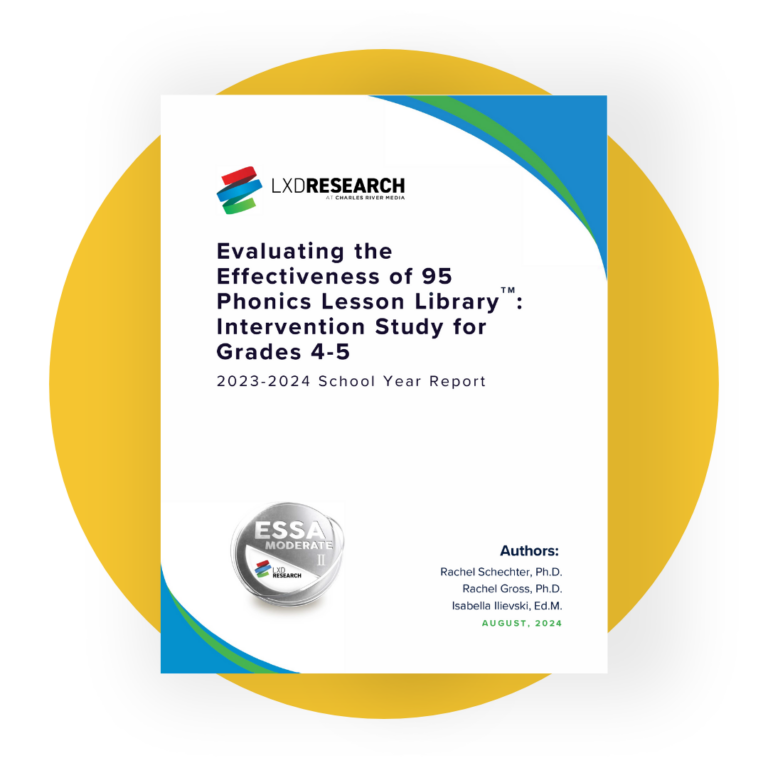
Download the research study: Evaluating the effectiveness of 95 Phonics Lesson Library in Ohio
Curious about the impact of 95 Percent Group’s Phonics Lesson Library in Ohio schools? This independent study by LXD Research examines how 95 Phonics Lesson Library helped 4th and 5th graders close reading gaps in just one year. See the key findings and data-backed results in the full report.
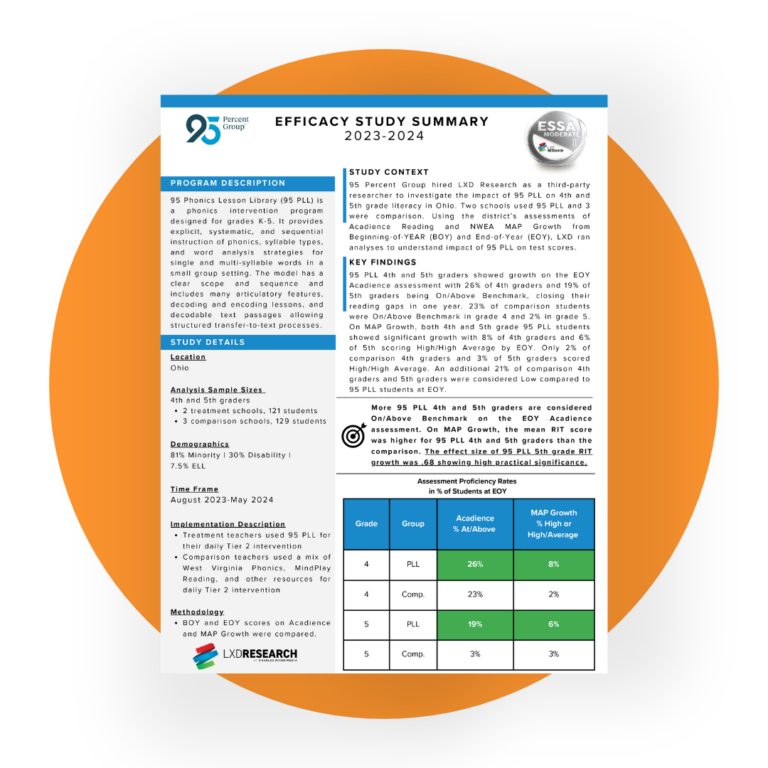
Download the efficacy study summary
Get a quick, summarized analysis and explanation of how students using 95 Phonics Lesson Library outperformed their peers.
Perhaps most encouraging was the program’s ability to lift struggling readers: while comparison classrooms saw an increase in students performing Well Below Benchmark, 95 Phonics Lesson Library classrooms witnessed a 19% reduction in this category among 5th graders. These results extended across both the Acadience and MAP Growth assessments, where 95 Phonics Lesson Library students consistently scored above the comparison group. With 26% of 4th graders and 19% of 5th graders reaching On/Above Benchmark status by year’s end, the program demonstrates that with the right support and personalized intervention approach, students can make substantial gains in their reading proficiency, closing achievement gaps and building confident, proficient readers.
Phonics Lesson Library is currently listed on the Evidence for ESSA website.
95 Phonics Lesson Library 2.0: Shaping the future of literacy intervention
While technology continues to evolve in education, introducing new possibilities for personalized learning and instruction, we believe maintaining strong pedagogical foundations remains essential. Future innovations will focus on enhancing teacher-directed instruction while preserving evidence-based instructional methods.
The future of literacy intervention lies in thoughtfully combining technology with proven teaching methods and intentional teacher support. We believe that the best road forward is one taken together—building innovation on a foundation of both reading science and fundamental teaching principles—ensuring every student receives the support needed to become a proficient reader.
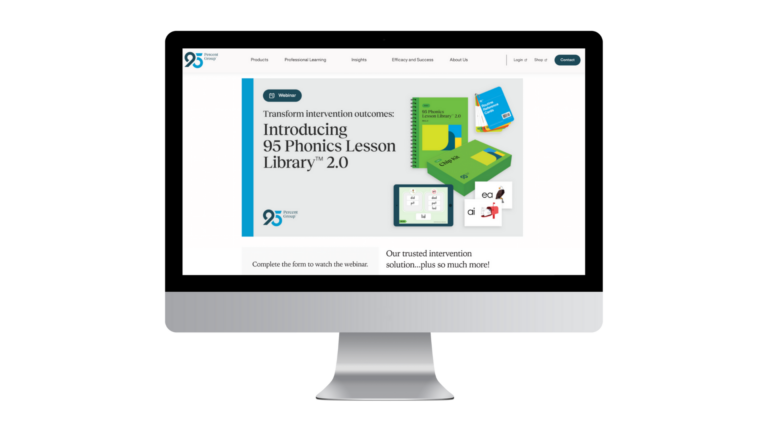
Watch the on-demand webinar now
Want a closer look at 95 Phonics Lesson Library 2.0? Watch our on-demand webinar for an in-depth walkthrough of its enhanced print and digital features, designed to make phonics intervention more efficient, flexible, and engaging.


